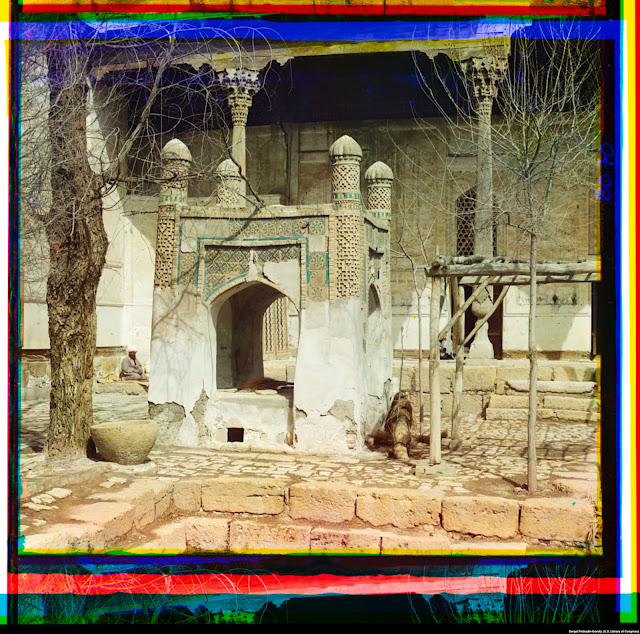RFE/RL’s photographer, Amos Chapple, recently published a fascinating photo essay about a 1907 trip to Uzbekistan by Russian photographer Sergey Prokudin-Gorsky, one of the pioneers of photographic colour prints.
As well as recognizing the pre-restoration buidlings, many Uzbek Journeys clients will be familiar with Prokudin-Gorsky's photos from his 6-year travels in the Russian empire from 1909. That trip had been commissioned by Tsar Nicholas II, who also provided a railroad-car darkroom. Those photographs are often displayed in Uzbek museums.
 |
| Sergei Prokudin-Gorsky (second from left) waiting in vain for a break in the clouds to observe a solar eclipse from Central Asia’s Tien-Shan mountains on January 1, 1907 |
The 1907 trip was to observe a solar eclipse from Central Asia's Tien-Shian mountains. Mr Chapple's text, captions and Prokudin'Gorsky's images are reproduced below.
Several years before he was famously commissioned by the tsar to photograph the Russian Empire in color, chemist Prokudin-Gorsky set off on an expedition to what is now Uzbekistan to observe a solar eclipse.
The weeks-long trip failed in its main goal after cloud cover blocked any glimpse of the eclipse, but the journey was not a lost cause. With his German-made camera that enabled vivid color images to be produced, Prokudin-Gorsky explored the backstreets and ancient centers of Samarkand and Bukhara, capturing photographs unlike any that had been taken before.
 |
| A carpenter strips bark from fresh timber on a back road in Samarkand. |
 |
| An Islamic shrine stands inside the Bahoutdin
Architectural Complex on the outskirts of Bukhara. The heavily-restored
shrine still stands. |
 |
| Men pose outside an Islamic school in Samarkand. |
Prokudin-Gorsky perfected an early method of colour photography that required three separate images of each scene to be shot with colour filters. When the three images were sandwiched together and had red, green, and blue light shone through them, a color image could be projected.
 |
| A view over central Samarkand from Registan Square |
 |
| A woman in a burqa stands outside a residence in Samarkand |
Prokudin-Gorsky made three trips to what is now Uzbekistan but was then part of the Russian Empire.
 |
| Men sell medicinal products in Samarkand |
Prokudin-Gorsky’s first trip to Central Asia was for the abortive 1907
attempt to record the solar eclipse, the second and third were in 1911
after he received backing from the tsar to photograph the Russian
Empire.
 |
| Bukhara's interior minister with a ceremonial sword |
It is unclear when the more than 200 photos Prokudin-Gorsky shot in Central Asia were taken, but photos like this -- of Bukhara's interior minister with a ceremonial sword, which required access to government buildings -- were probably made during the 1911 expeditions, when the photographer had a letter of recommendation from the tsar.
 |
| Two shackled prisoners from Bukhara’s notorious dungeon |
The photo above was taken just a few meters from the "bug pit" where two British officers, Stoddart and Conolly were tortured before eventually being beheaded in 1842 by the emir of Bukhara.
 |
| Men are held in the "debtors prison" inside the Bukhara dungeon |
Bukharans who owed either taxes to the government or money to other people were held in the prison but allowed out to work until they had repaid their debts.
 |
| A building inside the emir's palace in Bukhara |
A local historian advised that this building was destroyed during the 1920 Soviet invasion of the ancient city.
 |
| Sunlight illuminates Samarkand’s Shah-i-Zinda Mosque, one of Samarkand’s most important cemeteries |
After the 1917 Bolshevik Revolution, Prokudin-Gorsky fled Russia and eventually settled in Paris. Soon after his death in 1944, the U.S. Library Of Congress purchased 1,902 images -- including more than 200 shot in Central Asia -- from the great photographer's relatives.
Related posts:
Ernst Cohn-Wiener Collection: Uzbekistan, Turkmenistan, Kazakhstan and Kyrgyzstan 1924 - 1925
Paul Nadar's Images of Turkestan 1890
Strolling Through Samarkand in 1930
Khudaybergen Divanov - Father of Uzbek Photography











